The Aria luxury riverboat cruises on the Amazon River depart from Iquitos, Peru.
Custom built for travel on Amazon rivers, the small ship provides quality boutique-type accommodations with gourmet cuisine, while exploring the world's largest forest and river system.
You may now travel remote Amazon waters with a level of comfort and service that was not available just a few years ago. The ship is operated by Aqua Expeditions, the pioneer in luxury class riverboats in Peru. The ship maintains a minimum of one staff person to one guest.
The Amazon Cruise itineraries travel the area of the confluence of the Marañón and Ucayali Rivers which form the Amazon River and into the Pacaya Samiria National Reserve. Amazon Cruise tour options include itineraries of 7 Nights, 4 Nights, or 3 Nights onboard ship.
![]()
The Aria Luxury Riverboat
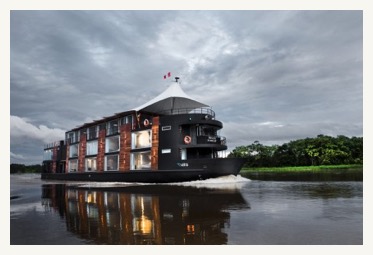
Beginning with the Peruvian section of the Amazon River, one of the world’s last great unexplored regions, Galli Zugaro commissioned the custom design of the Aqua Amazon, the first cruise ship to set sail on this stretch of the Amazon. As of July 2016, the Aqua is no longer in operation.
Increased demand for Aqua Expeditions uniquely intimate, life enriching river safari led to the launch of a second custom designed vessel, the Aria Amazon in 2011, with 16 suites designed by Puig with a similar five-star boutique hotel sophistication, and cruising the same captivating stretch of the Peruvian Amazon amidst equally thoughtful comforts and fascinating wildlife.
Prices & Dates
Contact us to check 2024 & 2025 rates and dates.
Contact us to check date availability and special discounts on selected departures.
All rates are USD per person in double occupancy; single supplement +25% regular rates.
Child Policy: 7 year age minimum on all departures, child under 12 years old will receive a 20% discount.
Third person sleeping on sofa bed will receive a 20% discount
Third person being a child under 12 years old sleeping on sofa bed pays US $500 per night
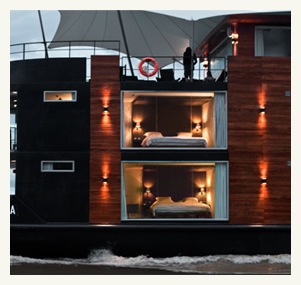
NOTES:
The rates above are priced based on per person, double occupancy of suites and master suites.
Included in your all inclusive rate are:
• All meals while onboard • All excursions • All beverages (non-alcoholic, house wine and beer) • Transfers to/from vessel when arriving on recommended flights • Pacaya Samiria entrance fee
Not Included:
• Air tickets to and from Iquitos • Guide and crew gratuities • Boutique purchases
M/V ARIA
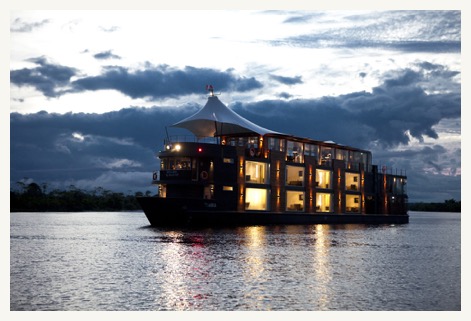
The M/V Aria can accommodate a maximum of 32 cruise ship guests plus crew. This luxury cruise ship is the perfect size to sail along the Amazon River, providing extremely comfortable lounge, outdoor jacuzzi, exercise room, dining and sleeping accommodations and modern navigation technologies and standards for cruise ship travel and safety on the water.
All 16 Design Suites on the Aria Amazon across the first and second deck measure 23 square meters (250 square feet), with individual air conditioning, polished timber flooring and a wall of floor to ceiling glass facing the Amazon River. En suite bathrooms with rain shower and organic bath amenities incorporate the latest eco-sensitive technology. Soft lighting, natural fibers and neutral hues create a relaxing and luxuriously comfortable enclave where one’s only challenge may be to decide whether to gaze upon the Amazon from atop the California king size bed (which can be separated into two twin beds) made with 100% Peruvian cotton high thread count sheets or while lounging on the cozy window-side day bed, binoculars in hand.
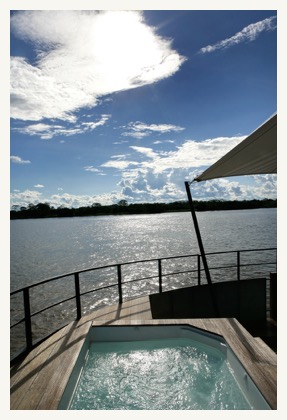
M/V ARIA Amazon River Expedition Cruise
8-Days Sample Itinerary
(A full daily itinerary is available upon request, based on high-water or low water seasons.)
Day 1: Friday IQUITOS / AMAZON RIVER Afternoon flight from Lima to Iquitos, in the heart of the Peruvian Amazon region. After you’ve claimed your luggage and are met by your local guide, you board an air-conditioned bus for your journey to the river to board the M/V Aria awaits.
From the moment you step on board, you will enjoy the ship’s atmosphere of low-key luxury. As you settle into your handsomely appointed, over-sized suite, you will feel the vessel begin to move –the beginning of one of the great adventures of your life. Stand on the Upper Deck to take in the view, as the M/V Aria leaves Iquitos behind.
Over the next seven days, you will also sail along the two largest tributaries of the Amazon, the Ucayali and the Marañon, as well as the mighty Amazon itself. You are embarking on a spectacular adventure, to a place visited by only a few of even the most experienced world travelers.
Before dinner we will perform a routine safety drill and have the first of the nightly briefings about your adventure to follow. You will meet the naturalist guides and the cruise director, who will use video, photos, and maps to explain the details of your journey into the Amazon.
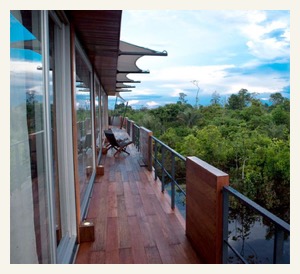
At the welcome dinner, you may sample some fine South American wine, and enjoy the truly world-class cuisine, created by Executive Chef Pedro Miguel Schiaffino, whose restaurant, Malabar, is the one of the best in all of Lima. Schiaffino’s recipes, with the imaginative use of local products – fruit, fish, spices – make every meal a delightful adventure. (The menu always offers choices, including a vegetarian option.) Toast the beginning of a beautiful journey. Perhaps you may enjoy a nightcap on the Upper Deck, under the stars, before retiring.
Day 2: Saturday AMAZON / YANAYACU / YACAPANA/YARAPA
Early Morning Skiff Expedition on the Amazon River to watch the sun rise over this green world filled with wonderful wildlife.
After breakfast (the daily breakfast buffet features a wide choice of traditional breakfast egg dishes, plus Peruvian specialties, and fresh-squeezed fruit juices) is an excusriosn by skiffs to the Yacapana Islands, called the “the Isle of the Iguana” thanks to the great number of these reptiles.
After lunch and siesta, is an late afternoon expedition to the Yarapa River.
As the sun sets, you will have the once-in-a-lifetime opportunity to see and photograph both gray and pink freshwater dolphins. Once the sun sets and the jungle is dark, we begin our search for caiman, frogs, and different kinds of nightlife. Once the sun sets and the jungle is dark, we begin our search for caiman, frogs, and different kinds of nightlife. This night, the M/V Aria continues upstream, toward the headwaters of the Amazon River, where the Ucayali, Marañon, and the Amazon Rivers merge.
Day 3: Sunday / PACAYA-SAMIRIA NATIONAL RESERVE

A full day of exploring the Amazon rainforest and Yanallpa river systems with nature walks and wildlife boating excursions. Today you may see a great variety of bird, howler and capuchin monkeys, the squirrel-sized monkeys called tamarins, dusky titi and pigmy marmoset monkeys, pink and gray river dolphins, and a vast variety of birds, and learn about the important medical value of jungle plants, see giant Kapok Trees (ceiba pentandra)in addition to caiman and dolphins.
Day 4: Monday BIRTHPLACE OF THE AMAZON / AMAZON VILLAGE / NAUTA TOWN

NOTE: In the afternoon, fellow passengers who have taken the three-night cruise itinerary depart in Nauta for transfer to Iquitos. In the evening, new passengers arriving for a four night cruise itinerary arrive from Nauta for dinner onboard.
Day 5: Tuesday AMAZON RIVER TRIBUTARIES / PACAYA SAMIRIA NATIONAL RESERVE
Another full day of meeting locals and exploring the Amazon rainforest and river systems with nature walks and boating excursions.
Day 6: Wednesday TACSHA RIVER / PACAYA SAMIRIA / SAN MARTIN DE TIPISHCA
Another full day of meeting locals and exploring the Amazon rainforest and river systems with nature walks and boating excursions - including an evening boat outing to listen for and locate nocturnal creatures.creatures, including, perhaps, huge caimans.
Day 7: Thursday TAHUAYO/CHARO LAKE
A morning boating excursion along the Yanayacu or Yanayaquillo Rivers for visits with locals and wildife viewing. At lunchtime, the ship starts sailing down the Amazon River river toward Iquitos.
After lunch is an excursion along the the dark waters of the Tahuayo River and fishing on Lake Charo. A good place to see the abundant wildlife such as sparrows, hawks, monkeys and sloths. After our arrival at Lake Charo, you will be using the fishing gear to fish for piranhas and other specious. While you fish, our nature guides will tell you the history of the lake and its residents.
After dinner the ship will continue its journey down stream through the night towards Iquitos.
Before your gourmet farewell dinner is a briefing in the Top Lounge to recap you itinerary and sightings. After dinner, your guides will introduce some of the crew members that you have not yet met, but who have been busy with the “behind the scenes” work that has helped to create a seamless experience. There may even be a bit of musical entertainment!
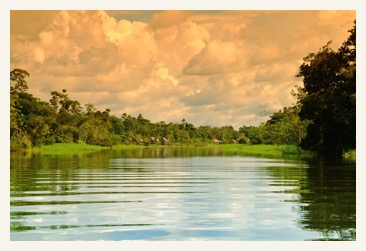
Day 8: Friday ARRIVAL IN IQUITOS / CITY TOUR / TRANSFER TO THE AIRPORT After breakfast, with weather and time permitting, this will be the last opportunity to see how people live along the Amazon — by visiting the lively riverside community of Belen, in Iquitos, by skiff. Here, where the houses and shops actually float on the river during some months, you will see the bustling food market for the entire Peruvian Amazon. All local inhabitants throughout the region sell and purchase goods here.
Some groups may instead take a short skiff ride to visit the Boras indigenous community, on the Momon River. The Bora tribe has made every effort to maintain its traditional culture since arriving from deep inside the rainforest more than 30 years ago. Today they will perform some of their most colorful dances for you.
After lunch, you debark the ship to explore the unique jungle city of Iquitos. This bustling town, complete with a house built by Gustave Eiffel, was once a rich center of the rubber industry. En route, we will visit the Manatee Rescue Center, where biologists and volunteers care for endangered Amazon manatees that conservation authorities have seized from local people and fishermen. Biologists will give a presentation about the project and its efforts to help these helpless mammals. You will also see how the manatees are cared for and are prepared for re-introduction into their natural habitat. Finally, we will stop at the San Juan Amazonian Indian Market, for a last chance to shop for local crafts.
In the late afternoon, your guides will help you with the airport check-in for flight back to Lima, or transfer to an Iquitos hotel if staying extra overnights.
Note: All itineraries are subject to change, due to weather and other conditions.
Click here for a short video of the Amazon River Cruise on the M/V Aria.

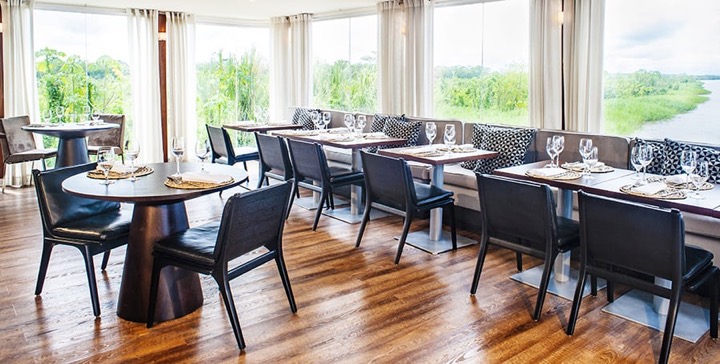

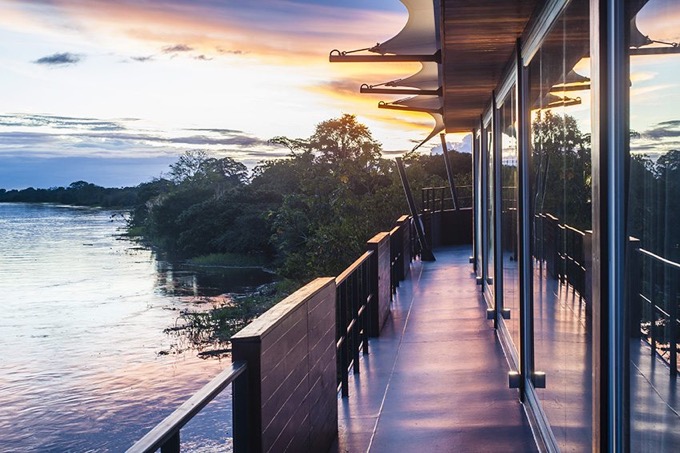
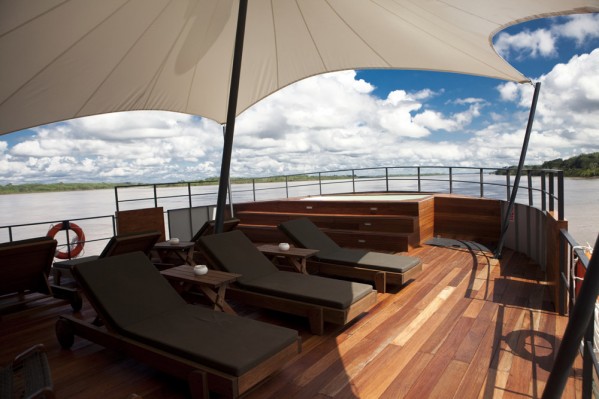
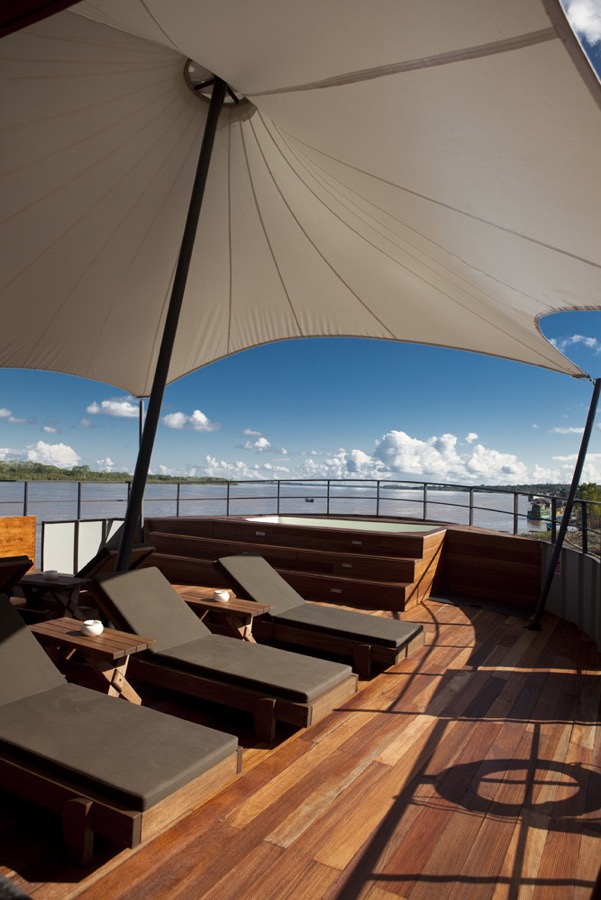

![]()
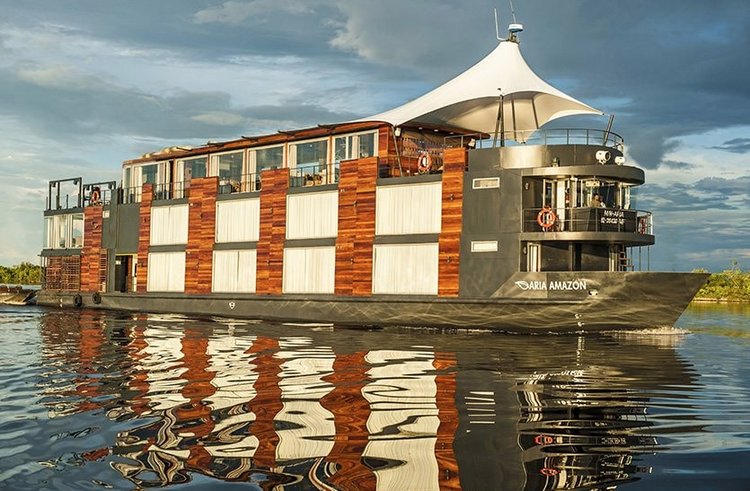
Vessel Specifications
- Year Built: 2011
- Port of Embarkation: Iquitos, Peru
- Vessel’s Registry: Peru
- Type of Vessel: River Expedition Vessel
- Length: 147 feet / 45 meters
- Beam: 29.5 feet / 9 meters
- Draft: 5 feet / 1.5 meters
- Gross Tonnage: 500 tons
- Cruising Speed: 12 knots
- Electricity: 220 volts
- Engines: 2 Cummins 400 HP Marine Engines
- Generators: 2 x 135 KVA Cummins (encapsulated for noise reduction)
- Water: 9,000-liter water treatment plant
- Safety on board the Aria Amazon: Radio communication with separate battery pack; satellite phone; life jackets, fire extinguishers and smoke detectors in each cabin; flares and signals; automatic defibrillator on board.
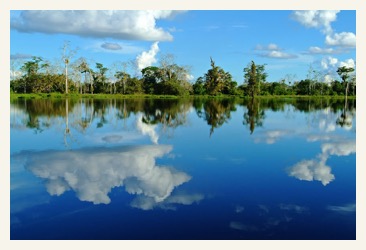
- Launch Boats Used for Shore Excursions from the Aria Amazon: Four auxiliary aluminum launch boats equipped with four-stroke low emission engines; constant radio communication with the main vessel. Each boat has a capacity of 8 passengers.
- Aria Amazon Crew: 24, including a cruise director, paramedic and 4 English speaking naturalist guides.
- Aria Amazon Capacity: Up to 32 passengers with private facilities (Additional accommodation for one child in each cabin)
- Accommodations and Cabins: 16 suites (8 Design Suites measuring 23.2 square meters /250 square feet on the first deck and 8 Design Suites measuring 23.2 square meters / 250 square feet on the second deck). All outside-facing with floor to ceiling panoramic windows. All air conditioned with en suite sitting areas. Four interconnecting suites for families.
- Unique Cabin Features and Amenities: Amazon river facing panoramic windows; air conditioning; twin beds that convert to a California king-sized bed; en suite sitting area, bathroom with shower, toilet, sink, cabinet, hairdryer, hot water around the clock and a basket of toiletries; internal communications system.
- Common Living and Social Areas: Indoor Bar; Lounge; Dining Room; Outside Lounge; Outdoor Jacuzzi; Exercise Room; Observation Deck; Boutique
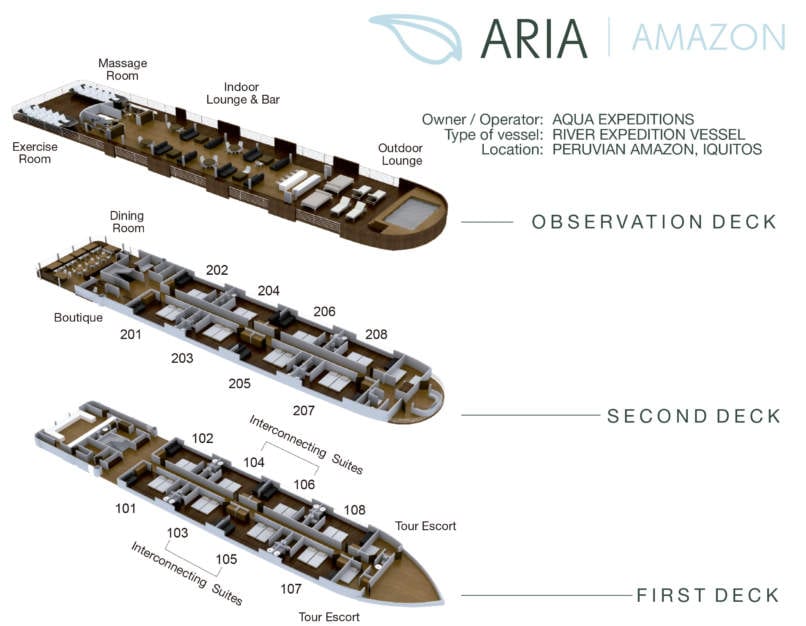
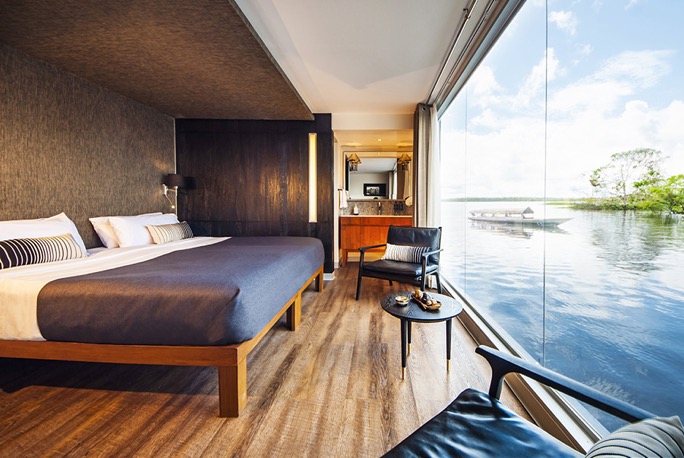
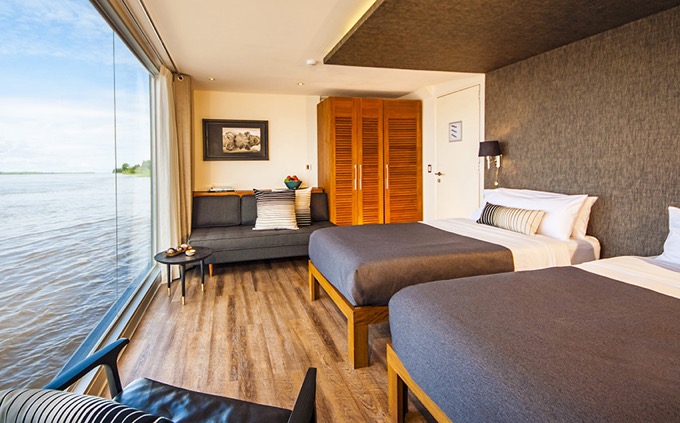

FAQs
What does my all-inclusive cruise price include?

Why should I book a cruise on the Aqua Nera or Aria?
Aqua Expeditions pioneered the concept of ultra-luxurious small ship cruises on the Peruvian stretch of the Amazon River. The first ship, the Aqua Amazon immediately began to sell out as word spread about the possibility to enjoy supremely luxurious accommodations and fine dining while exploring some of the most remote, wildlife rich areas of the Amazon River. Beyond building this stylish and safe cruising vessel, founder Francesco Galli Zugaro identified local guides who knew every animal, bird and tree of the Amazon jungle—most had grown up there. These Aqua Expeditions guides provide life changing travel and educational experiences for our guests. His success was so great that almost immediately he began construction on a second boat, the Aria Amazon, which also sails the Amazon.
Is it better to book the early or can I book on short notice?

Should I buy travel insurance?
Travelers are strongly advised to purchase trip cancellation insurance, which will reimburse the cost of air tickets and other non-refundable trip payments. International medical, baggage loss, and delay insurance are also recommended. If you miss the vessel because of a weather-related flight cancellation, we will not reimburse the cost of the reservation, since flight cancellations are beyond our control and we have to comply with our schedules. If Aqua or Aria is not able to sail (i.e. due to force majeure or mechanical failure), Aqua Expeditions reserves the right to substitute another vessel. If the travelers do not take this option, Aqua Expeditions reserves the right to cancel the trip upon a refund pro rata per cruise night not used or, as an alternative, will offer credit toward a future cruise.
What are the Visa and Passport Requirements for Peru?
Citizens of the United States, Canada, European Union, Switzerland, Australia, New Zealand, Japan, ASEAN, and most South American countries do not need to apply in advance for a tourist visa to visit Peru. A passport valid for at least six months longer than you intend to stay in Peru is required to receive a Tourist Visa at the border or the international airport upon arrival in Peru. Tourists must also provide evidence of return or onward travel. Travelers to Peru will receive a card from the airlines or Peruvian Immigration upon arrival stating the length of approved stay (usually 90 days). Extensions are not available, and overstays will result in fines. Visit the Embassy of Peru website in country that issued your passport for the most current visa information and to determine if you must apply for a visa in advance of arrival. Peru does not require any immunizations for entry, although it recommends vaccination against yellow fever.
What is the Embarkation Point?
Aqua Expeditions naturalists meet all guests at Coronel FAP Francisco Secada Vignetta International Airport (IQT) in the remote Amazonian city of Iquitos, Peru. During high water season, from December to May, guests board the Aqua and the Aria in Iquitos, while from June to November, our guides will begin acquaint passengers with highlights of our luxury Amazon cruise itineraries on the scenic one-and-a-half hour drive through the Peruvian countryside to the village of Nauta for boarding. Guests return to Iquitos at the end of Aqua Expeditions 4 and 7 night itineraries while our 3-night passengers disembark in Nauta then continue by road to Iquitos. The largest city in the Peruvian Amazon and the fifth largest city in Peru, Iquitos is furthest inland port city in the world, some 3,200 kilometers (2,000 miles) upriver from the Atlantic Ocean and accessible only by river or air. This isolated town that was once a rich center of the rubber industry still retains the historic charms of 18th-century Moorish Spanish churches, rubber baron mansions now mostly abandoned and the so-called Iron Building designed by Gustave Eiffel, intended for the capital of Bolivia in the late 19th century but abandoned here en route up the Amazon. An extra overnight in Iquitos is recommended. With flights permitting, at the end of every journey aboard the Aqua Amazon and the Aria Amazon, before we head for the airport, we visit the Manatee Rescue Center, where biologists and volunteers care for endangered Amazon manatees rescued from local people who mistakenly think this will be like taking care of a pet fish or puppy that can swim. Aqua Expeditions has been working with the Manatee Rescue Center from its inception six years ago. Thanks to our guests, we support all the educational programs of the Manatee Rescue Center, with a focus on raising awareness in local schools.
How do I get to Iquitos?

How old do you have to be to cruise?
The minimum age to travel on the Aqua Amazon is seven. Passengers must be at least 18 years of age to travel without their parents or guardians. If any occupant in the cabin is under 18, then a passenger at least 25 years old must be booked in the cabin with them. The only exception is that children under age 18 may be allowed to have their own cabin if they are in a connected suite shared by their parents or guardians.
Do you welcome families with children?

Do you need a minimum of passengers to guarantee my departure date?
No, all of our departures are guaranteed. Please review our current list of available departures for our 3,4 and 7-night cruises.
Do I need any shots before traveling to the Amazon?
Malaria medication and yellow fever shots are not required for travelers coming into the region, however they are recommended. Please consult your physician.
What should I pack?
Life is casual aboard the ships, so you can feel free to pack light for your Amazon River cruise, with some specific items to wear and use on excursions into the Amazon rainforest and jungle. Please bring comfortable walking shoes, lightweight long pants and long sleeved shirts for our excursions, as well as a wide-brimmed hat, sunscreen, extra socks, mosquito repellant with DEET, and of course, your camera, with charger and extra batteries. You may wish to include some items that you can give away to the locals (t-shirts, pens and paper are especially prized) and the small medical goods on our Pack for a Purpose list that will be provided. For our guests who prefer to pack light, Aqua Expeditions created three Donation Kits: hygiene, school supplies and fishing. Each contains items of the greatest use and value to our Amazonia neighbors. These and good quality mosquito nets are available for purchase in the Aqua Amazon boutique. By purchasing these for distribution in the villages we visit, our guests help in meaningful, effective ways. During meals in the dining room we ask our guests to wear casual clothing and shoes. We provide rubber boots for wetland excursions. We also provide waterproof ponchos with hoods to protect against rain. There will be hairdryers available in every suite. We allow you to bring as much luggage as you like, but suggest the use of soft suitcases/bags for easy storage. How much you bring, however, may be determined by the airlines, which have limits on both checked and carry-on baggage, so you will need to check on your specific flights.
How much luggage may I bring?
Are there porters available at the airport and the pier?
We allow you to bring as much luggage as you like, but suggest the use of soft suitcases/bags for easy storage. How much you bring, however, may be determined by the airlines and you should check for your specific flights. Aqua Expeditions porters are available at both the airport and pier. They will make sure that your bags arrive at the embarkation point. As soon as you have identified your luggage, our porters will take your suitcases to your suite.
Should I bring gifts to give away to the locals?
Aqua Expeditions guests enjoy passing out small gifts from home when we visit local villages. We strongly advise sharing t-shirts, pens and paper instead of cash or candy. Aqua Expeditions also participates with Pack for a Purpose [HYPERLINK: http://www.packforapurpose.org/docs/countries/peru/aqua-expeditions.shtml]
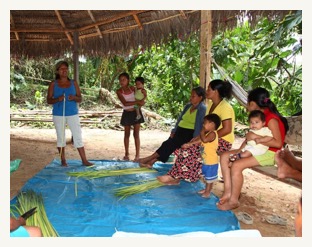
What is a shore excursion? How physically challenging are they?
A shore excursion can be anything from exploring remote tributaries by skiff, to spotting monkeys and birds along a jungle trail, from visiting a local village to fishing on one of Amazonia’s beautiful lakes. They vary in level of exertion, but most travelers who are reasonably fit will have no trouble participating in every excursion. Passengers will be divided into three groups of eight people for shore excursions, with each group led by an Aqua Expeditions trained naturalist guide. Guides will rotate among the groups, so that each passenger can benefit from their specialized knowledge. Our guides speak fluent English, and one speaks French and another speaks German. We recommend that groups requiring any other language bring a translator, if necessary. Each evening, your guides will brief you on what to expect on the next day’s excursions. Typically, we will navigate the Amazon River or one of its tributaries at night, arriving in a new location, for a new adventure, in the early morning. Passengers opting to go on the early morning excursions will get a wakeup call at approximately 6 a.m. The Aqua Amazon is equipped with three auxiliary aluminum skiffs that will take passengers along the waterways or ferry them to the landing point for onshore excursions. These comfortable speedboats are equipped with 4 stroke low-emission engines and are in constant radio communication with the main vessel. Each boat has capacity for eight passengers, plus guide and launch pilot. Excursions last two to three hours, allowing plenty of time to explore, learn about and photograph the abundant wildlife. Land excursions involve disembarking on dry riverbank, however for your safety, your guide and skiff driver will always be available to assist you. When the excursions are in the Pacaya-Samiria Reserve, we follow marked trails, walking at a leisurely pace for up to one hour. Guests should be in good physical health in order to be able to make the most of their Amazon cruise. The daily nature excursions may include walking on irregular terrain. Getting in and out of the skiffs occasionally requires some physical effort. Our naturalist guides are always here to help you. We provide rubber boots for wetland excursions and recommend taking comfortable walking shoes for walking on the dry paths. We also provide waterproof ponchos with hoods to protect against rain.
Instead of going on an organized shore excursion, can we go off on our own?

Are the cabins assigned in advance?
A Suite or Master Suite will be assigned to you when we confirm your reservation. All suites are described and numbered on the Deck Plans. You may request a specific cabin depending on your preference and we will assign it if available. In order to ensure the optimum safety and comfort of all our passengers, we allow a maximum of three people in each suite.
Do all suites include an Amazon River view?
Yes, all suites have outward-facing panoramic windows, giving every cabin a river view. The Master Suites have even larger windows that offer you magnificent views of the passing landscape. If you choose to leave the blackout curtains pulled back, the dawn light will awaken you in the mornings, as Amazonia life and wildlife begins anew.
Is there any difference between the lower and upper-deck suites?
Dimensions and all features are exactly the same for both decks.
Do you have cell, satellite or internet connectivity on board?

Do you have laundry services on board?
There is no laundry service.
What type of medical capabilities do you have on board?
We have a paramedic on board at all times plus our first-aid trained staff can handle minor scrapes, bites or sprains. There are no handicapped facilities.
What health and safety precautions are taken on board?
No particular vaccines are required for Peru, but some are strongly advised, such as anti-malaria medication and yellow fever shots for travel to the Amazon Basin. We suggest that you consult your physician before your departure regarding travel health and preventative measures, and check the U.S. Centers for Disease Control website for the latest information. http://wwwn.cdc.gov/travel/default.aspx. If you plan to extend your Peru journey to Cusco and Machu Picchu, ask your doctor about medication for altitude sickness. Once all the passengers have boarded, the crew will conduct a mandatory safety drill. Please be sure to check exactly where the life vests are located in your cabin. Memorize your way to the deck in case an emergency should arise. Consult your Cruise Director or Guide regarding any questions you may have. Life vests are provided for use while onboard the skiffs and you are required to wear them. Always hold the guide or crewmember’s hand while embarking or disembarking, since the boat ladder and deck may be wet and slippery. It is important for us to verify that all our passengers are on board prior to departure. Each ship is equipped with a satellite phone for emergency access.
What precautions should I take to prevent crime while traveling in Peru?
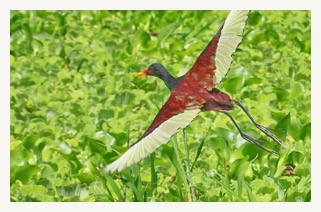
Will I have access to a safe deposit box?
Yes. All cabins have safe deposit boxes with instructions for their use.
Can we drink the water aboard ship?
When you board the Aqua Amazon, you will be supplied with a complimentary Aqua Expeditions water bottle that is yours to keep. Water refill stations are available throughout the vessel. We recommend that you do not drink the water from the faucet while on board.
Is motion sickness ever a problem?
Not really. On the surface, the Amazon main river looks more like open sea, with some waves, however we sail on some of the calmest waters in the world. In addition, our crew continually receives the most accurate weather information and navigates accordingly, which decreases the incidence of motion sickness for our guests. While navigating by skiff deeper into the flooded forest, the smaller tributaries take you to calm, mirrored water.
How do I pay for purchases on board?

What about tipping?
We are often asked what gratuity is appropriate for guides and crew, and our response is that the quality of service should determine the amount of any tip. From experience, we recommend an amount in the range of US $20 – $30 per passenger per day for the crew (to be divided among all the crew members) and between US $7 – $10 per passenger per day for the guides. The total suggested tip for Aqua Amazon staff on your trip would therefore be somewhere between US $81.00 – US $120.00 per passenger in total for those on a 3 night trip or US $108.00 – US $ 160.00 per passenger those on a 4 night trip. Envelopes are provided for your convenience. Please note that these amounts are suggested levels of gratuities and that this is entirely at the discretion of our guests aboard the Aqua Amazon.
Are there smoking areas?
Smoking is forbidden inside the Aqua Amazon. It is allowed only in the Outdoor Lounge and on the Observation Deck. If you want to smoke here, please ask the bartender for an ashtray. Do not throw your cigarette stubs or ash into the Amazon River or its tributaries.
What’s the drinking age on the ships?
You must be at least 18 years old to legally consume beer, wine, and other alcoholic beverages in Peru and on the Aqua Amazon.
How is the food?

What if I have special dietary needs?
If you have special dietary requests, we strongly encourage you to inform Aqua Expeditions at the time of booking, or at least by 30 days prior to embarkation. Every effort will be made to cater to special dietary needs, and to accommodate special requests, subject to a given product’s availability in Peru.
Is room service available?
Room service is not available, but will be provided in the event of passenger illness.
What is Peru’s time zone?
The time in Peru is one hour behind Eastern Standard Time in the United States.
What currency is used in Peru?
The Nuevo Sol (New Sol) is the official currency of Peru. One dollar equals about 2.6 New Soles.
How do I protect myself against mosquitoes in the rainforest?

• DEET remains the most effective repellent on the market. Look for products with at least 30 per cent (10 per cent for children) of the active ingredient, such as Ultrathon lotion. DEET shouldn´t be used on irritated skin or under clothing.
• Other repellents recommended by the U.S. Centers of Diseases Control are Picadrin, the active ingredient in Cutter Advanced Sport spray.
• For non-chemical bug protection, cover up with long-sleeve shirts, long pants and netted hats. Light colors are best.
What is the Climate And Weather In Peru’s Amazon?
The climate in Iquitos, Peru, is warm and humid year round, with average annual maximum temperature of 31°C (88°F) and minimum of 21°C (70°F). Weather along Peru’s Amazon River remains generally warm with some rainfall even during low water season, from June to November. In fact, despite being the “rainy” high water season from December to May, the Amazon only gets about 10% more rain than falls in the low water season. Guests can expect the high water season to be relatively wetter: during this period, the Amazon region receives a little more than half (60%) of its total rainfall. During the high water season, the average temperature is a relatively cooler 86 degrees Fahrenheit, only 12 degrees cooler than in the low water season. Each season brings some differences in the plant and animal life in Amazonia, however both are excellent times to visit the Amazon.
WHAT ARE THE DEPOSITS, PAYMENT SCHEDULE AND CANCELLATION POLICY?
- A $500 deposit per person is required to confirm your reservation
- Final payment for all programs is due 90 days prior to departure.
- Final payment will be automatically charged to the credit card used for deposit on the due date unless you make alternate arrangements prior to the final payment due date.
- Travel Insurance is highly recommended (and policy options will be provided): There is $500 per person cancellation fee from time of booking to 120 days prior to departure. Cancellation fee of 100% of the full program cost per person from 89 to 0 days prior to departure.
CRUISE ROUTE MAPS
Expedition Amazon River Cruise on the Aria - 8 days / 7 nights

Explorer Amazon River Cruise on the Aria - 5 days / 4 nights

Discovery Amazon River Cruise on the Aria - 4 days / 3 nights

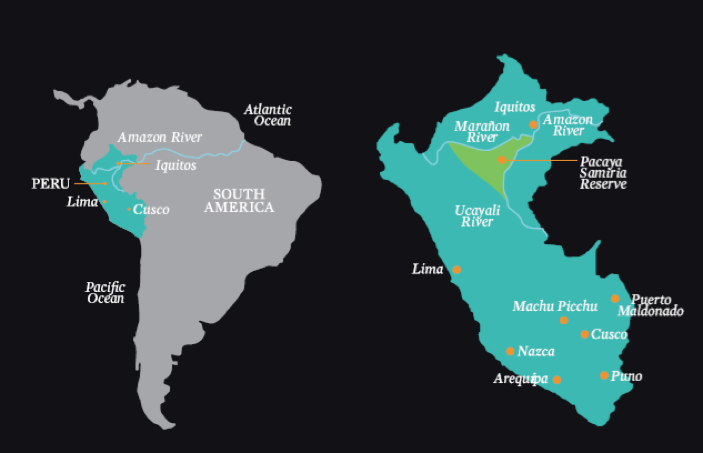
AMAZON BIRD LIST
# COMMON NAME SCIENTIFIC NAME LOCAL NAME PROBABILITY OF VIEWING (10 = BEST)
| | | | | LOW WATER | HIGH WATER |
| 1 | Tropical Kingbird | Tyrannus melancholicus | Cazamosca común | 10 | 10 |
| 2 | Great Kiskadee | Pitangus sulphuratus | Victordías grande | 10 | 10 |
| 3 | Lesser Kiskadee | Philohydor lictor | Victordías chico | 10 | 10 |
| 4 | Social Flycatcher | Myiozetetes similis | Cazamosca social | 6 | 8 |
| 5 | Rusty-margined Flycatcher | Myiozetetes cayanensis | Cazamosca orillero | 5 | 8 |
| 6 | Boat-billed Flycatcher | Megarynchus pitangua | Mosquero picudo | 5 | 8 |
| 7 | Piratic Flycatcher | Legatus leucophaius | Mosquero pirata | 5 | 8 |
| 8 | Swainson´s Flycatcher | Myarchus swainsoni | Copetón cungagris | 8 | 8 |
| 9 | Dusky-capped Flycatcher | Myarchus tuberculifer | Copetón crestigris | 5 | 7 |
| 10 | Short-crested Flycatcher | Myarchus ferox | Copetón cresticorta | 4 | 7 |
| 11 | Amazonian Royal Flycatcher | Onychorhyncus coronatus | Mosquero real | 5 | 5 |
| 12 | Streaked Flycatcher | Myiodynastes maculatus | Mosquero rayado | 5 | 5 |
| 13 | Eastern Kingbird (migrant) | Tyrannus tyrannus | Tirano norteño | | 10 |
| 14 | Fork-tailed Flycatcher (migrant) | Tyrannus savana | Tijereta sabanera | | 10 |
| 15 | Vermilion Flycatcher | Pyrocephalus rubinus | Mosquero rojo | | 6 |
| 16 | White-headed Marsh-tyrant | Arundinicola leucocephala | Tirano cabeciblanco | 10 | 10 |
| 17 | Drab Water-tyrant | Ochthornis littoralis | Tirano orillero | 10 | 10 |
| 18 | Southern Rough-winged Swallow | Stelgidopteryx ruficollis | Golondrina sureña | 10 | 10 |
| 19 | White-winged Swallow | Tachycineta albiventer | Golondrina aliblanca | 10 | 10 |
| 20 | Short-tailed Swift | Chaetura Brachyura | Vencejo colicorta | 5 | 10 |
| 21 | White-collared Swallow | Streptoprocne zonaris | Golondrina de collar | 2 | 6 |
| 22 | Brown-chested Martin | Phaeoprogne tapera | Martín pechimarron | 10 | 10 |
| 23 | Purple Martin | Progne subis | Martín púrpura | 5 | 10 |
| 24 | Grey-breasted Martin | Progne chalybea | Martín pechigris | 5 | 10 |
| 25 | Southern Martin | Progne elegans | Martín sureño | 5 | 10 |
| 26 | Russet-backed Oropendola | Psarocolius angustifrons | Bocholocho | 10 | 10 |
| 27 | Yellow-rumped Cacique | Cacicus cela | Paucar común | 10 | 10 |
| 28 | Solitary Cacique | Cacicus solitarius | Paucar solitario | 5 | 5 |
| 29 | Orange-backed Troupial | Icterus icterus | Turpial naranja | 4 | 7 |
| 30 | Oriole Blackbird | Gymnomystax mexicanus | Oriol negriamarillo | 10 | 10 |
| 31 | Yellow-hooded Blackbird | Agelaius icterocephalus | Oriol encapuchado | 10 | 10 |
| 32 | Shiny Cowbird | Molothrus bonariensis | Chichiriche brillante | 10 | 5 |
| 33 | Giant Cowbird | Scaphidura oryzivora | Chichiriche grande | 10 | 5 |
| 34 | Velvet-fronted Grackle | Lampropsar tanagrinus | Clarinero d´ terciopelo | 5 | 7 |
| 35 | Swallow Tanager | Tersina viridis | Suisui golndrina | 5 | 8 |
| 36 | Hooded Tanager | Nemosia pileata | Suisui de capucha | 5 | 8 |
| 37 | Blue-gray Tanager | Thraupis episcopus | Suisui grisazul | 10 | 10 |
| 38 | Palm Tanager | Thraupis palmarum | Suisui de palmera | 7 | 8 |
| 39 | Masked Crimson Tanager | Ramphocelus nigrogularis | Suisui enmascarado | 10 | 10 |
| 40 | Silver-beaked Tanager | Ramphocelus carbo | Suisui picoplateado | 10 | 10 |
| 41 | Grey-headed Tanager | Eucometis penicillata | Suisui cabeza gris | 5 | 6 |
| 42 | Magpie Tanager | Cissopis leveriana | Suisui blanquinegro | 4 | 7 |
| 43 | Red-capped Cardinal | Paroaria gularis | Cardenal pucahuma | 10 | 10 |
| 44 | Greyish Saltator | Saltator coerulescens | Saltador gris | 4 | 7 |
| 45 | Paradise Tanager | Tangara chilensis | Suisui del paraiso | 6 | 8 |
| 46 | Blue Dacnis | Dacnis cayana | Dacnis azul | 5 | 6 |
| 47 | Purple Honeycreeper | Cyanerpes caeruleus | Mielero púrpura | 5 | 6 |
| 48 | Green Honeycreeper | Chlorophanes spiza | Mielero verde | 5 | 6 |
| 49 | Thick-billed Euphonia | Euphonia laniirostris | Eufonia picoancho | 5 | 6 |
| 50 | White-vented Euphonia | Euphonia minuta | Eufonia ventriblanco | 5 | 6 |
| 51 | Orange-bellied Euphonia | Euphonia xanthogaster | Eufonia panzanaranja | 5 | 6 |
| 52 | Purple-throated Euphonia | Euphonia chlorotica | Eufonia cungapúrpura | 5 | 6 |
| 53 | Blue-black Grassquit | Volatinia jacarina | Semillero negriazul | 8 | 6 |
| 54 | Yellow-browed Sparrow | Ammodramus aurifrons | Gorrión cejiamarillo | 8 | 6 |
| 55 | Bananaquit | Coereba flaveola pacifica | Reinita mielera | 4 | 7 |
| 56 | Lined Seedeater | Sporophila lineola | Semillero lineado | 10 | 10 |
| 57 | Lesson´s Seedeater | Sporophila bouvronides | Semillero de lesson | 4 | 8 |
| 58 | Chestnut-bellied Seedeater | Sporophila castaneiventris | Semillero pancimarr. | 10 | 10 |
| 59 | Chestnut-bellied Seed-finch (lesser) | Oryzoborus angolensis | Semillero menor | 10 | 10 |
| 60 | Musician Wren (organ Wren) | Cyphorhinus aradus | Flauterito | 5 | 4 |
| 61 | Buff-breasted Wren | Thryothorus leucotis | Cucarachero pechicre. | 5 | 5 |
| 62 | Coraya Wren | Thryothorus coraya | Cucarachero coraya | 5 | 5 |
| 63 | White-breasted Wood-Wren | Henicorhina leucosticta | Cucarachero pechib. | 5 | 5 |
| 64 | Scaly-breasted Wren | Microcerculus marginatus | Cucara. Pechoteresho | 5 | 5 |
| 65 | Thrush-like Wren | Campylorhynchus turdinus | Cucara. Zorzal | 7 | 7 |
| 66 | Black capped donacobius | Donacobius atricapillus | Zorzal coroninegra | 10 | 10 |
| 67 | Violaceous Jay | Cyanocorax violaceus | Urraca violeta | 4 | 7 |
| 68 | Masked Tityra | Tityra semifasciata | Titira de máscara | 7 | 7 |
| 69 | Black-tailed Tityra | Tityra cayana | Titira colinegra | 7 | 7 |
| 70 | Wire-tailed Manakin | Pipra filicauda | Saltarín colialambre | 6 | 6 |
| 71 | White-bearded Manakin | Manacus manacus | Saltarín barbiblanca | 5 | 5 |
| 72 | Blue-crowned Manakin | Lepidothrix coronata | Saltarín coroniazul | 5 | 5 |
| 73 | Blue-backed Manakin | Chiroxiphia pareola | Saltarín espalda azul | 5 | 5 |
| 74 | Golden-headed Manakin | Pipra erythocephala | Saltarín cabeza dorada | 5 | 5 |
| 75 | Greater Schiffornis manakin | Schiffornis major | Saltarín schiffornis | 7 | 7 |
| 76 | Bright-rumped Attila | Attila spadiceus | Atila brillante | 5 | 5 |
| 77 | Dull-capped Attila (white-eyed) | Attila bolivianus | Atila ojiblanco | 3 | 7 |
| 78 | Cinnamon Atila | Attila cinnamomeus | Atila acanelado | 7 | 7 |
| 79 | Sirystes | Sirystes sibilator | Siristes | 5 | 5 |
| 80 | Spotted Tody-Flycatcher | Todirostrum maculatum | Mosquerito moteado | 5 | 5 |
| 81 | White-eyed Tody Tyrant | Hemitriccus zosterops | Mosquerito ojiblanco | 5 | 5 |
| 82 | Short-tailed Pygmy-tyrant | Myiornis ecaudatus | Mosquerito pigmeo | 4 | 7 |
| 83 | Bare-necked Fruit Crow | Gymnoderus foetidus | Cuervo frutero cuello. | 10 | 10 |
| 84 | Purple-throated Fruitcrow | Querula purpurata | C. frutero cungamora. | 5 | 8 |
| 85 | Amazonian Umbrellabird | Cephalopterus ornatus | Pájaro paraguas | 5 | 7 |
| 86 | Screaming Piha | Lipaugus vociferans | Piha gritona | 3 | 6 |
| 87 | Plum-throated Cotinga | cotinga maynana | Cotinga cungamorada | 6 | 8 |
| 88 | Spangled Cotinga | Cotinga cayana | Cotinga salpicado | 5 | 5 |
| 89 | Black-faced Antthrush | Formicarius analis | Gallito horm.carinegra | 5 | 5 |
| 90 | Rufous-capped Antthrush | Formicarius colma | G.hormuig.coronirojo | 5 | 5 |
| 91 | Black-spotted Bare-eye | Phlegopsis nigromaculata | Ojipelado moteado | 5 | 5 |
| 92 | Scale-backed Antbird | Hylophylax poecilinotus | Hormiguero escamado | 5 | 5 |
| 93 | Spot-backed Antbird | Hylophylax naevius | H. espaldamanchada | 5 | 5 |
| 94 | Dot-backed Antbird | Hylophylax punctulatus | H. puntidorsal | 5 | 5 |
| 95 | Black-throated Antbird | Myrmeciza atrothorax | H. gargantinegra | 5 | 5 |
| 96 | Plumbeous Antbird | Myrmeciza hyperythra | H. plomizo | 5 | 5 |
| 97 | Sooty Antbird | Myrmeciza fortis | H. tiznado | 5 | 5 |
| 98 | White-shouldered Antbird | Myrmeciza melanoceps | H. hombriblanco | 5 | 5 |
| 99 | Silvered Antbird | Sclateria naevia | H. plateado | 5 | 5 |
| 100 | Warbling Antbird | Hypocnemis cantator | H. gorjeador | 5 | 5 |
| 101 | Black-faced Antbird | Myrmoborus myotherinus | H. carinegra | 5 | 5 |
| 102 | White-browed Antbird | Myrmoborus leucophrys | H. cejiblanca | 5 | 5 |
| 103 | Black-chinned Antbird | Hypocnemoides melanopogon | H. barbinegro | 5 | 5 |
| 104 | Spot-winged Antbird | Schistocichla leucostigma | H. alimanchado | 5 | 5 |
| 105 | Black Antbird | Cercomacra serva | Hormiguero negro | 5 | 5 |
| 106 | Grey Antbird | Cercomacra cinerascens | Hormiguero gris | 5 | 5 |
| 107 | Blackish Antbird | Cercomacra nigrescens | Hormiguero pardo | 5 | 5 |
| 108 | Grey Antwren | Myrmotherula menetriesii | Hormiguerito gris | 5 | 5 |
| 109 | Long-winged Antwren | Myrmotherula longipennis | Hormiguerito alilarga | 5 | 5 |
| 110 | White-eyed Antwren | Myrmotherula leucophtalma | Hormiguer. Ojiblanco | 5 | 5 |
| 111 | White-flanked Antwren | Myrmotherula axillaris | Hormig. flanquiblanco | 5 | 5 |
| 112 | Pygmy Antwren | Myrmotherula brachyura | Hormiguero pigmeo | 5 | 5 |
| 113 | Amazonian Streaked-Antwren | Myrmotherula multostriata | Hormig. Rayado | 5 | 5 |
| 114 | Plain-throated Antwren | Myrmotherula Hauxwelli | Hormig. Cungallano | 5 | 5 |
| 115 | Cinereous Antshrike | Thamnomanes caesius | Batará cinéreo | 4 | 6 |
| 116 | Amazonian Antshrike | Thamnophilus amazonicus | Batará amazónico | 5 | 5 |
| 117 | Mouse-coloured Antshrike | Thamnophilus murinus | Batará murinos | 5 | 5 |
| 118 | Black-capped Antshrike | Thamnophilus schistaceus | Batará cabezinegra | 5 | 5 |
| 119 | Barred Antshrike | Thamnophilus doliatus | Batará de barras | 5 | 7 |
| 120 | Great Antshrike | Taraba major | Batará grande | 5 | 7 |
| 121 | Curve-billed Scythebill | Campylorhampchus procurvoides | Picoguadaña picocurvo | 5 | 5 |
| 122 | Long-billed Woodcreeper | Nasica longirostris | Trepador picolargo | 5 | 7 |
| 123 | Striped Woodcreeper | Xiphorhynchus obsoletus | Trepador listado | 5 | 6 |
| 124 | Straight-billed Woodcreeper | Xiphorhynchus picus | Trepador picorecto | 5 | 6 |
| 125 | Strong-billed Woodcreeper | Xiphocolaptes promeropirhynchus | Trepador picofuerte | 5 | 6 |
| 126 | Cinnamon-throated Woodcreeper | Dendrexetastes rufigula | Trepa. Garganticanela | 5 | 6 |
| 127 | Plain-brown Woodcreeper | Dendrocincla fuliginosa | Trepa. Amarronado | 5 | 6 |
| 128 | Olivaceous Woodcreeper | Sittasomus griseicapillus | Trepador olivado | 5 | 6 |
| 129 | Short-billed Leaftosser | Sclerurus rufigularis | Tirahojas piquicorto | 5 | 5 |
| 130 | Black-tailed Leaftosser | Sclerurus caudacutus | Tirahojas colinegra | 5 | 5 |
| 131 | Buff-throated Foliage-gleaner | Automolus ochrolaemus | Rascahojas cungaclaro | 5 | 5 |
| 132 | Olive-backed Foliage Gleaner | Automolus infuscatus | Rasca. Dorsiolivo | 5 | 5 |
| 133 | Red-and-White Spinetail | Certhiaxis mustelinus | Colaespina rojiblanco | 6 | 8 |
| 134 | Ruddy Spinetail | Synallaxis rutilans | Colaespina rojizo | 5 | 5 |
| 135 | Parker´s Spinetail | Cranioleuca vulpecula | Colaespina Parker´s | 6 | 6 |
| 136 | Plain Xenops | Xenops minutus | Pico-lezna simple | 5 | 5 |
| 137 | Rufous-tailed Xenops | Xenops milleri | Pico-lezna coliroja | 5 | 5 |
| 138 | Pale-legged Hornero | Furnarius leucopus | Hornero patipálida | 5 | 7 |
| 139 | Lesser Hornero | Furnarius minor | Hornero chico | 5 | 5 |
| 140 | Crimson-crested Woodpecker | Campephilus melanoleucus | Carpintero crestiroja | 7 | 9 |
| 141 | Lineated Woodpecker | Dryocopus lineatus | Carpintero lineado | 7 | 9 |
| 142 | Cream-coloured Woodpecker | Semicinnamomeus | Carpintero cremoso | 8 | 8 |
| 143 | Chestnut Woodpecker | Celeus elegans | Carpintero castaño | 8 | 8 |
| 144 | Ringed Woodpecker | Celeus torquatus | Carpintero anillado | 6 | 6 |
| 145 | Little Woodpecker | Veniliornis passerinus | Carpintero chico | 6 | 6 |
| 146 | Spot-breasted Woodpecker | Colaptes punctigula | Carp. Pechipunteado | 6 | 7 |
| 147 | Yellow-tufted Woodpecker | Melanerpes cruentatus | Carp. Copeteamarillo | 8 | 8 |
| 148 | Plain-breasted Piculet | Picumnus castelnau | Carpinterito pchillano | 6 | 6 |
| 149 | Rufous-Breasted Piculet | Picumnus rufiventris | Carpinterito pechirojo | 5 | 5 |
| 150 | White-throated Toucan (Cuvier´s) | Ramphastos cuvieri | Tucan tiojuan | 5 | 8 |
| 151 | Yellow-ridged Toucan | Ramphastos culminatus | T. rabadilla amarilla | 5 | 8 |
| 152 | Chestnut-eared Aracari | Pteroglossus castanotis | Tucaneta orejicastaño | 6 | 10 |
| 153 | Lettered Aracari | Pteroglossus inscriptus | Tucaneta letreado | 5 | 10 |
| 154 | Ivory-billed Aracari | Pteroglossus azara | Tucaneta pico d´marfil | 4 | 7 |
| 155 | Scarlet-crowned Barbet | Capito aurovirens | Barbudo coroniroja | 5 | 8 |
| 156 | Lemon-throated Barbet | Eubucco richardsoni | Barbudo gargantilimón | 5 | 7 |
| 157 | Gilded Barbet | Capito auratus | Barbudo brilloso | 4 | 7 |
| 158 | Black-fronted Nunbird | Monasa nigrifrons | Tihuacuro frentinegra | 10 | 10 |
| 159 | White-fronted Nunbird | Monasa morphoeus | Tihuacuro frentiblanca | 4 | 6 |
| 160 | Swallow-winged Puffbird | Chelidoptera tenebrosa | Buco golondrina | 5 | 8 |
| 161 | Brown Nunlet | Nonnula brunnea | Monjita marrón | 5 | 6 |
| 162 | Rusty-breasted Nunlet | Nonnula rubecula | Monjita pechirojo | 5 | 6 |
| 163 | White-necked Puffbird | Notharchus macrorhynchos | Buco cuelliblanco | 4 | 6 |
| 164 | Pied Puffbird | Notharchus tectus | Buco blanquinegro | 4 | 6 |
| 165 | Collared Puffbird | Bucco capensis | Buco de collar | 5 | 5 |
| 166 | White-chinned Jacamar | Galbula tombacea | Jacamar barbiblanco | 6 | 7 |
| 167 | Yellow-billed Jacamar | Galbula albirostris | Jacamar picoamarillo | 4 | 6 |
| 168 | Blue-cheeked Jacamar | Galbula cyanicollis | Jacamar cachetiazul | 5 | 7 |
| 169 | White-eared Jacamar | Galbalcyrhinchus leucotis | Jacamar orejiblanco | 10 | 10 |
| 170 | Rufous Motmot | Baryphthengus martii | Relojero rojizo | 4 | 5 |
| 171 | Blue-crowned Motmot | Momotus momota | Relojero coroniazul | 4 | 5 |
| 172 | Ringed Kingfisher | Megaceryle torquata | Martín pescador g. | 10 | 10 |
| 173 | Green Kingfisher | Chloroceryle americana | M. pescador verde | 10 | 10 |
| 174 | Amazon Kingfisher | Chloroceryle amazona | M. pescador amazón. | 10 | 10 |
| 175 | Green-and-rufous Kingfisher | Chloroceryle inda | M. pescador rojizo | 7 | 8 |
| 176 | American Pygmy Kingfisher | Chloroceryle aenea | M.pescador pigmeo | 7 | 8 |
| 177 | Black-tailed Trogon | Trogon melanurus | Trogón colinegra | 6 | 8 |
| 178 | White-tailed Trogon | Trogon viridis | Trogón coliblanco | 6 | 8 |
| 179 | Violaceous Trogon | Trogon violaceus | Trogón violeta | 5 | 8 |
| 180 | Blue-crowned Trogon | Trogon curucui | Trogón coroniazul | 4 | 6 |
| 181 | Collared Trogon | Trogon collaris | Trogón de collar | 4 | 6 |
| 182 | Black-eared Fairy | Heliothryx auritus | Colibrí orejinegra | 5 | 5 |
| 183 | Long-billed Starthroat | Heliomaster longirostris | Colibrí picudo | 5 | 5 |
| 184 | Black-throated Mango | Anthrocothorax nigricollis | Mango cunganegra | 4 | 7 |
| 185 | White-necked Jacobin | Florisuga mellivora | Colibrí nuquiblanca | 4 | 7 |
| 186 | Black-throated Hermit | Phaethornis atrimentalis | Ermitaño cunganegra | 4 | 7 |
| 187 | Straight-billed Hermit | Phaethornis bourcieri | Ermitaño picorrecto | 4 | 7 |
| 188 | Pauraque (nightjar) | Nyctidromus albicollis | Tohuayo común | 10 | 10 |
| 189 | Ladder-tailed Nightjar | Hydropsalis climacocerca | Tohuayo coliescalera | 5 | 8 |
| 190 | Short-tailed Nighthawk | Lurocalis semitorquatus | Paparo colicorta | 5 | 8 |
| 191 | Sand-coloured Nighthawk | Chordeilis rupestris | Paparo | 10 | 8 |
| 192 | Common Potoo | Nyctibius griseus | Ayaymama | 10 | 10 |
| 193 | Great Potoo | Nyctibius grandis | Ayaymama grande | 10 | 10 |
| 194 | Spectacled Owl | Pulsatrix perpicillata | Buho de anteojos | 5 | 5 |
| 195 | Tropical Screech Owl | Megascops choliba | Buho urcututo | 5 | 5 |
| 196 | Ferruginous Pygmy Owl | Glaucidium nubicola | Buho pigmeo | 5 | 5 |
| 197 | Greater Ani | Crotophaga major | Locrero | 10 | 10 |
| 198 | Smooth-billed Ani | Crotophaga ani | Vacamuchacho | 10 | 10 |
| 199 | Yellow-billed Cuckoo | Coccyzus americanus | Chicua picoamarillo | 5 | 7 |
| 200 | Dark-billed Cuckoo | Coccyzus melacoryphus | Chicua picoscuro | 5 | 7 |
| 201 | Little Cuckoo | Piaya minuta | Chicua pequeña | 5 | 7 |
| 202 | Squirrel Cuckoo | Piaya cayana | Chicua grande | 6 | 8 |
| 203 | Hoatzin | Opisthocomus hoazin | Shansho | 10 | 10 |
| 204 | Mealy Parrot | Amazona farinosa | Uchpa loro | 10 | 10 |
| 205 | Orange-winged Amazon Parrot | Amazona amazonica | Loro aliamarilla | 6 | 7 |
| 206 | Yellow-crowned Amazon Parrot | Amazona ochrocephala | Loro coronamarilla | 6 | 7 |
| 207 | Short-tailed Parrot | Graydidascalus brachyurus | Loro colicorta | 10 | 10 |
| 208 | Festive Parrot | Amazona festiva | Loro hablador | 10 | 10 |
| 209 | Blue-headed Parrot | Pionus menstruus | Loro darandaran | 6 | 8 |
| 210 | Black-headed Parrot | Pionites melanocephalus | Loro chirricles | 6 | 8 |
| 211 | White-bellied Parrot | Pionites leucogaster | Chirricles pansiblanca | 6 | 8 |
| 212 | Blue-winged Parrolet | Forpus Xanthopterygius | Lorillo aliazul | 5 | 5 |
| 213 | Dusky-billed Parrolet | Forpus modestus | Lorillo piconegro | 5 | 5 |
| 214 | Cobalt-winged Parakeet | Brotogeris cyanoptera | Lorillo aliazul | 10 | 7 |
| 215 | Tui Parakeet | Brotogeris sanctithomae | Perico frenteamarillo | 7 | 7 |
| 216 | Canary-winged Parakeet (white) | Brotogeris versicolurus | Perico aliamarilla | 10 | 10 |
| 217 | White-eyed Parakeet | Aratinga leucophthalma | Perico ojoblanco | 10 | 10 |
| 218 | Dusky-headed Parakeet | Aratinga weddellii | Perico pedrito | 10 | 10 |
| 219 | Chestnut-fronted Macaw | Ara severus | Papagaillo carablanca | 10 | 10 |
| 220 | Red-bellied Macaw | Ara manilata | Papagaillo cariamarilla | 8 | 8 |
| 221 | Blue-and-yellow Macaw | Ara ararauna | Papagayo amarillo | 10 | 10 |
| 222 | Scarlet Macaw | Ara macao | Papagayo rojo | 5 | 8 |
| 223 | Red-and-green Macaw | Ara Chloropterus | Papagayo rojiverde | 5 | 7 |
| 224 | Ruddy Pigeon | Patagioenas subvinacea | Torcaza rojiza | 5 | 7 |
| 225 | Plumbeous Pigeon | Patagioenas plumbea | Torcaza plomiza | 5 | 7 |
| 226 | Yellow-billed Tern | Sternula superciliaris | Tibe chico | 10 | 10 |
| 227 | Large-billed Tern | Phaetusa simplex | Tibe grande | 10 | 10 |
| 228 | Black Skimmer | Rynchops niger | Tibe negro | 10 | |
| 229 | Spotted Sandpiper | Actitis macularius | Timelo moteado | 10 | 4 |
| 230 | Solitary Sandpiper | Tringa solitaria | Timelo solitario | 10 | |
| 231 | Lesser Yellowlegs | Tringa flavipes | Timelo patiamarilla | 8 | |
| 232 | Black-necked Stilt | Himantopus mexicanus | Timelo patalarga | 10 | |
| 233 | Wattled Jacana | Jacana jacana | Tuquituqui | 10 | 10 |
| 234 | Collared Plover | Charadrius collaris | Timelo de collar | 10 | |
| 235 | Pied Lapwing | Vanellus cayanus | Marinerito | 10 | |
| 236 | Sungrebe | Heliornis fulica | Ponponcito | 8 | 6 |
| 237 | Purple Gallinule | Porphyrula martinica | Gallareta purpura | 5 | 8 |
| 238 | Azure Gallinule | Porphyrula flavirostris | Gallareta azuleja | 5 | 8 |
| 239 | Grey-necked Woodrail | Aramides cajanea | Unchala | 5 | 8 |
| 240 | Russet-crowned Crake | Anurolimnas viridis | Unchalilla marron | 4 | 6 |
| 241 | Black-banded Crake | Anurolimnas fasciatus | Unchalilla de banda | 4 | 6 |
| 242 | Bat Falcon | Falco rufigularis | Halcón mashero | 7 | 7 |
| 243 | Collared Forest Falcon | Micrastur semitorquatus | Halcón pechogris | 4 | 7 |
| 244 | Laughing Falcon | Herpetotheres cachinnans | Huancahui | 7 | 8 |
| 245 | Yellow-headed Caracara | Milvago chimachima | Shihuango pálido | 10 | 10 |
| 246 | Black Caracara | Daptrius ater | Shihuango negro | 10 | 10 |
| 247 | Red-throated Caracara | Ibycter americanus | Tatatao | 4 | 6 |
| 248 | Harpy Eagle | Harpia harpyja | Aguila monero | 2 | 4 |
| 249 | Black-and-White Hawk Eagle | Spizastur melanoleucus | Aguila pechiblanco | 2 | 4 |
| 250 | Roadside Hawk | Buteo magnirostris | Gavilán pollero | 10 | 10 |
| 251 | Black-collared Hawk | Busarellus nigricolis | Mamavieja | 10 | 10 |
| 252 | Great Black Hawk | Buteogallus urubitinga | Gavilán negro | 10 | 10 |
| 253 | Crane Hawk | Geranospiza caerulescens | Gavilán ojorojo | 5 | 7 |
| 254 | Slate-coloured Hawk | Leucopternis schistaceus | Gavilán plomo | 7 | 7 |
| 255 | Plumbeous Kite | Ictinia plumbea | Gavilancillo plomo | 8 | 8 |
| 256 | Swallow-tailed Kite | Elanoides forticatus | Tijera chupa | 4 | 8 |
| 257 | Snail Kite | Rostrhamus sociabilis | Gavilán churero | 8 | 4 |
| 258 | Slender-billed Kite | Helicolestes hamatus | Gavilán cochero | 8 | 4 |
| 259 | Hook-billed Kite | Chondrohierax uncinatus | Gavilán picogancho | 8 | 4 |
| 260 | Grey-headed Kite | Leptodon cayanensis | Gavilancillo gris | 4 | 8 |
| 261 | Osprey | Pandion haliaetus | Tibe mama | 8 | 8 |
| 262 | Black Vulture | Coragyps atratus | Gallinazo negro | 10 | 10 |
| 263 | Turkey Vulture | Cathartes aura | Rinahui | 10 | 10 |
| 264 | Greater Yellow-headed Vulture | Cathartes Melambrotus | Rinahui cabezamarilla | 10 | 10 |
| 265 | King Vulture | Sarcoramphus papa | Condor amazónico | 4 | 4 |
| 266 | Jabiru Stork | Jabiru mycteria | Tuyuyo | 10 | |
| 267 | Wood Stork | Mycteria americana | Manshaco | 10 | |
| 268 | Green Ibis | Mesembrinibis Cayennensis | Corocoro | 7 | 7 |
| 269 | Limpkin | Aramus guarauna | Tarahui | 4 | 6 |
| 270 | Boat-billed Heron | Cochlearius cochlearius | Huapapa | 10 | 10 |
| 271 | Black-crowned Night Heron | Nycticorax nycticorax | Huapapilla | 10 | 7 |
| 272 | Striated Heron | Butorides striata | Garza quichatera | 10 | 10 |
| 273 | Agami Heron | Agamia agami | Garza pintada | 7 | 7 |
| 274 | Rufescent Tiger-heron | Tigrisoma lineatum | Pumagarza | 10 | 10 |
| 275 | Capped Heron | Pilherodius pileatus | Garza pintahuya | 10 | 10 |
| 276 | Snowy Egret | Egretta thula | Garza blanca chica | 10 | 10 |
| 277 | Great Egret | Ardea alba | Garza blanca grande | 10 | 10 |
| 278 | Cattle Egret | Bubulcus ibis | Garza ganadera | 8 | 8 |
| 279 | Cocoi Heron (white-necked) | Ardea cocoi | Garza ceniza | 10 | 10 |
| 280 | Neotropic Cormorant | Phalacrocorax brasilianus | Cushuri | 10 | 7 |
| 281 | Anhinga | Anhinga anhinga | Sharara | 10 | 7 |
| 282 | Wattled Curassow | Crax globulosa | Piurí | 2 | 5 |
| 283 | Razor-billed Curassow | Mitu tuberosum | Paujil común | 2 | 5 |
| 284 | Spix´s Guan | Penelope jacquacu | Puca cunga | 3 | 5 |
| 285 | Blue-throated Piping Guan | Pipile cumanensis | Pava gargantiazul | 3 | 5 |
| 286 | Speckled Chachalaca | Ortalis guttata | Manacaraco | 5 | 8 |
| 287 | Starred Wood-Quail | Odontophorus stellatus | Codorniz estrellado | 4 | 5 |
| 288 | Muscovy Duck | Cairina moschata | Sacha pato | 4 | 8 |
| 289 | Horned Screamer | Anhima cornuta | Camungo | 10 | 10 |
| 290 | Undulated Tinamou | Crypturellus undulatus | Perdíz común | 4 | 6 |
| 291 | Little Tinamou | Crypturellus soui | Perdíz chico | 4 | 6 |
| 292 | Great Tinamou | Tinamus major | Perdíz grande | 4 | 6 |
AMAZON WILDLIFE LIST
COMMON NAME SCIENTIFIC NAME LOCAL NAME PROBABILITY OF VIEWING (10 = BEST)
| | | | LOW WATER | HIGH WATER |
| Agouty Rodent | Dasyprocta fuliginosa | Añuje | 3 | 3 |
| Amazon Bamboo Rat | Dactylomys dactylinus | Conocono | 5 | 5 |
| Amazon Dwarf Squirrel | Microsciurus flaviventer | Huaihuasho chico | 3 | 5 |
| Bicolor-spined Porcupine | Coendou bicolor | Cashacushillo | 2 | 2 |
| Bolivian Squirrel Monkey | Saimiri boliviensis | Fraile grande | 5 | 8 |
| Brown Capuchin Monkey | Cebus apella | Machín negro | 7 | 8 |
| Brown-throated Three-toed Sloth | Bradypus variegatus | Pelejo | 10 | 10 |
| Capibara Rodent | Hydrochaeris hydrochaeris | Ronsoco | 5 | 5 |
| Collared Peccary | Tayassu tajacu | Sajino | 1 | 2 |
| Common Oposum | Didelphis marsupialis | Zorillo | 5 | 7 |
| Common Squirrel Monkey | Saimiri sciureus | Fraile común | 10 | 10 |
| Common Woolly Monkey | Lagothrix lagothricha | Mono choro | 1 | 2 |
| Dusky Titi Monkey | Callicebus moloch | Mono tocón | 4 | 6 |
| Giant Anteater | Myrmecophaga tridactyla | Hormiguero grande | 1 | 1 |
| Giant Otter | Pteronura brasiliensis | Lobo de río | 3 | 3 |
| Greater Fishing Bat | Noctilio leporinus | Masho pescador | 10 | 10 |
| Gray River Dolphin | Sotalia fluviatis | Bufeo gris | 10 | 10 |
| Jaguar | Panthera onca | Otorongo | 1 | 1 |
| Kinkajo (honey bear) | Potos flavus | Choshna | 4 | 5 |
| Long-nosed Bat | Rhynchonycteris naso | Masho chico | 10 | 10 |
| Manatee | Trichechus inunguis | Vaca marina | 1 | 1 |
| Margay | Leopardus wiedii | Huamburushi | 1 | 2 |
| Monk Saki Monkey | Pithesia monachus | Huapo negro | 6 | 8 |
| Mustached Tamarin Monkey | Saguinus mystax | Pichico masatero | 3 | 5 |
| Nine-banded Armadillo | Dasypus novemcinctus | Carachupa | 1 | 1 |
| Noisy Night Monkey (owl monkey ) | Aotus vociferans | Musmuqui | 5 | 7 |
| Northern Amazon Red Squirrel | Sciurus igniventris | Huaihuasho rojo | 4 | 6 |
| Ocelot | Leopardus pardalis | Tigrillo | 1 | 2 |
| Paca Rodent | Agouti paca | Majás | 3 | 3 |
| Pale-fronted Capuchin Monkey | Cebus albifrons | Machín blanco | 4 | 5 |
| Pink River Dolphin | Inia geoffrensis | Bufeo colorado | 10 | 10 |
| Pygmy Marmoset Monkey | Cebuella pygmaea | Mono leoncito | 5 | 5 |
| Red Brocket Deer | Mazama americana | Venado | 1 | 1 |
| Red Howler Monkey | Alouatta seniculus | Mono coto | 9 | 9 |
| Saddle-backed Tamarin Monkey | Saguinus fuscicollis | Mono pichico | 5 | 8 |
| Silky Anteater | Cyclopes didactylus | Tapia pelejo | 1 | 1 |
| South American Coati | Nasua nasua | Achuni | 2 | 2 |
| Tamandua Anteater (southern) | Tamandua tetradactyla | Shihui | 3 | 3 |
| Tapir (Brazilian) | Tapirus terrestris | Sacha vaca | 1 | 1 |
| Tayra | Eira barbara | Manco | 2 | 5 |
| Two-toed Sloth | Choloepus didactylus | Coto pelejo | 2 | 2 |
| White-bellied Spider Monkey | Ateles belzebuth | Mono maquisapa | 1 | 2 |
| White-lipped Peccary | Tayassu pecari | Huangana | 1 | 2 |
| Yellow-crowned Brush-tailed Tree Rat | Isothrix bistriata | Cantinero | 8 | 8 |
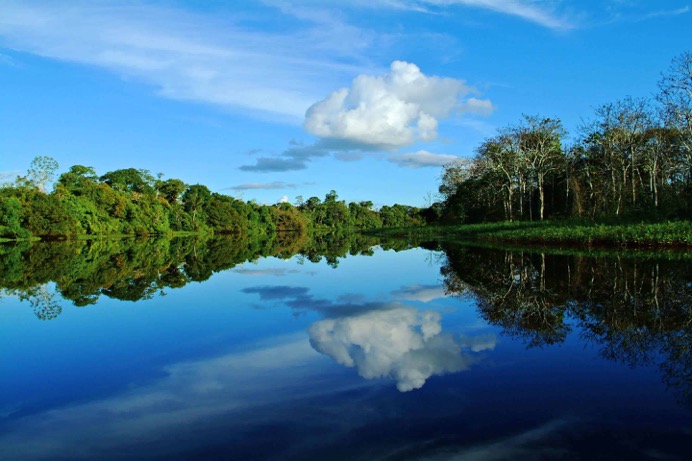
All our Amazon tours may be combined with other explorations in Peru.
Return to the top of this webpage :)
